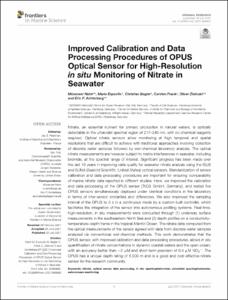Improved Calibration and Data Processing Procedures of OPUS Optical Sensor for High-Resolution in situ Monitoring of Nitrate in Seawater.

View/
Average rating
votes
Date
2021Author
Nehir, Münevver
Esposito, Mario
Begler, Christian
Frank, Carsten
Zielinski, Oliver
Achterberg, Eric P.
Metadata
Show full item recordAbstract
Nitrate, an essential nutrient for primary production in natural waters, is optically
detectable in the ultraviolet spectral region of 217–240 nm, with no chemical reagents
required. Optical nitrate sensors allow monitoring at high temporal and spatial
resolutions that are difficult to achieve with traditional approaches involving collection
of discrete water samples followed by wet-chemical laboratory analysis. The optical
nitrate measurements are however subject to matrix interferences in seawater, including
bromide, at the spectral range of interest. Significant progress has been made over
the last 10 years in improving data quality for seawater nitrate analysis using the ISUS
and SUNA (Seabird Scientific, United States) optical sensors. Standardization of sensor
calibration and data processing procedures are important for ensuring comparability
of marine nitrate data reported in different studies. Here, we improved the calibration
and data processing of the OPUS sensor (.....
Journal
Frontiers in Marine ScienceVolume
8.Issue
Article 663800Page Range
15pp.Document Language
enSustainable Development Goals (SDG)
14.aEssential Ocean Variables (EOV)
NutrientsDOI Original
10.3389/fmars.2021.663800Citation
Nehir, M., Esposito, M., Begler, C., Frank, C., Zielinski, O. and Achterberg, E.P. (2021) Improved Calibration and Data Processing Procedures of OPUS Optical Sensor for High-Resolution in situ Monitoring of Nitrate in Seawater. Frontiers in Marine Scence, 8:663800, 15pp. DOI: 10.3389/fmars.2021.663800Collections
The following license files are associated with this item:
 Repository of community practices in Ocean Research, Applications and Data/Information Management
Repository of community practices in Ocean Research, Applications and Data/Information Management
